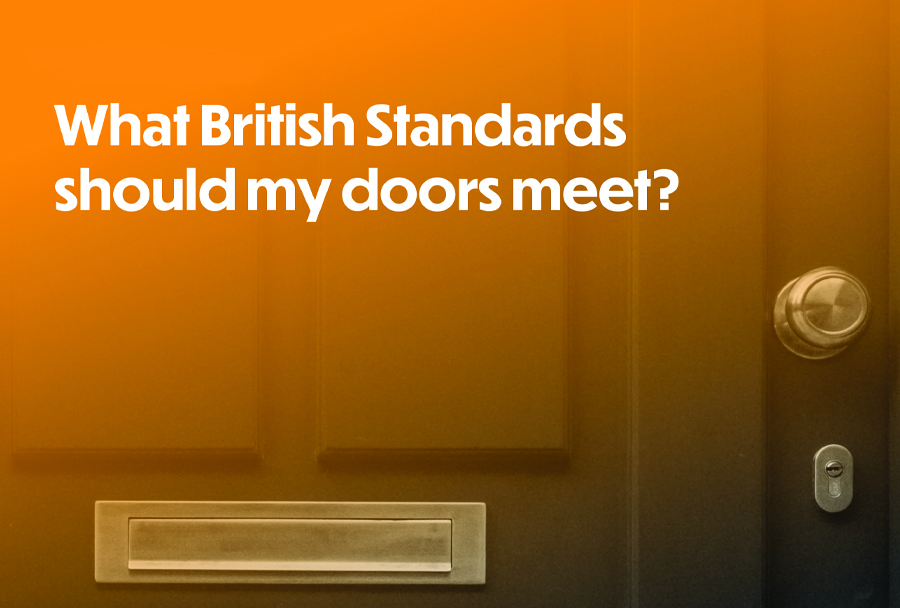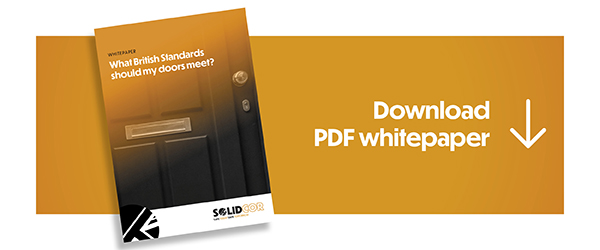What British Standards should my doors meet?
WHITEPAPER
The duties and responsibilities of those involved in the design, construction and ongoing provision of safe and suitable social housing are considerable and weighty, and for good reason. We need no reminder of exactly why the meeting and maintaining of standards is so important to keep tenants safe and secure. However, the world of regulation can be confusing and difficult to navigate, with different standards and standardising organisations, and often additional guidance and legislation laid over the top! Doors are no exception, being an integral part of the fabric of a building. As a supplier of safe and compliant doorsets to the social housing sector, we know from our clients that there is a lot of confusion around standards – it’s not surprising because the UK’s building regulations are some of the most complex in the world. In this paper we have tried to cut through the jargon and review the three key standards that apply to doors in this setting. In very broad terms, you could summarise the key standards that apply to doors as follows: − BS EN 16034 specifies the test conditions that fire doors must perform to. − BS EN 14351-1 provides guidance on the appropriate performance levels required for air permeability, water tightness and wind pressure. − BS 8300 identifies the measures that should be taken to ensure accessibility for the physically impaired.
Why do some standards ‘specify’ and others ‘identify’?
There are two types of standards. One is a specification, which is a set of absolute requirements for achieving a specific outcome. The other is a code of practice, which is guidance on best practice given in the form of recommendation. A good rule of thumb is that in all formal standards, requirements are identified by the words ‘shall’ and recommendations are identified by the word ‘should’. For example BS EN 16034 is a specification, whereas BS 8300 is a code of practice.
What’s the difference between a harmonised standard and a designated standard?
A harmonised standard is one that has been developed by a recognised European Standards Organisation. For fire doors, this means that a standard has been agreed by different standardising organisations to establish a mutual understanding of test results and inter-changeability of products. In essence, someone in France can buy a fire door made in the UK, that meets BS EN 16034, knowing that it meets a certain standard of fire protection. Hundreds of harmonised standards have been accepted and adopted in the UK, but when the UK left the EU, the Government started calling them designated standards. However, it means exactly the same thing!
Let’s look at each of the standards in more detail:
BS EN 16034 (and BS 476) In the UK, current Approved Document B of Building Regulations (ADB) requires that fire doors be tested and certified to either BS 476 Part 20 and 22 or BS EN 10634 Part 1, which identifies the performance characteristics of a fire door in terms of fire resistance and smoke control. You may well ask what the difference is between the standards – broadly speaking, they are often referred to as the British standard and the European standard. BS EN 16034 is a harmonised standard, developed by a recognised European Standards Organisation. This means it would be accepted in Europe, whereas BS 476 would not, being a UK standard only. Both BS EN 16034 and BS 476 are credible in the UK and referenced in UK Building Regulations. A fire-door that meets these standards means that all its component parts are compliant with their own relevant standard, and that the whole doorset has been tested for fire resistance. The limitations of BS 476 It is worth clarifying that, although BS 476 is still recognised in the UK, in December 2022 the Government launched a consultation proposing to remove it from ADB and replace it with the harmonised standard BS EN 16034. The consultation was closed in March 2023 and no further details have been published to date. Whilst many manufacturers already test to BS EN 16034, some still test to BS 476 – how and when they would switch over to BS EN 16034 has yet to be decided.
Smoke, as well as fire
It is important to note that BS EN 16034 is split into two tests; Part 1 deals with heat and flame resistance and part 3 deals with smoke resistance. For example, a doorset could pass a test for EN16034-1, but fail EN16034-3. This is obviously a key area of consideration when specifying doorsets in multi-occupancy dwellings, where smoke-free exit routes are of the utmost importance (and bearing in mind that it is well established that smoke kills more people than fire).
Fire Safety Act and Fire Safety Order
Clearly, social landlords have responsibilities under the Regulatory Reform (Fire Safety) Order 2005, and the Fire Safety Act 2021 and Fire Safety Regulations 2022 which provide clarification around it. For the sake of brevity, we won’t expand on that here, but it does warrant a mention.
Achieving clarity around compliance is important
Although change like this often comes with a level of confusion and/or disruption, most people involved with the built environment (and therefore concerned with the safety of its occupants) agree that it does not make sense to have two methods of complying to a single requirement. In her report, ‘Building a Safer Future’, Dame Judith Hackett referred to the lack of consistency in ADB and she proposed that removing BS 476 would achieve greater clarity and consistency in standards. This would then make it easier for the Office for Product Safety and Standards (OPSS) to assess fire performance for internal fire doors. For clarity, the OPSS was identified as the product regulator of choice in the Independent Hackett Review of Building Regulations and Fire Safety following the Grenfell Tower tragedy.
BS EN 14351-1 covers external doors
We’ve looked at the standard that covers fire resistance and smoke control of fire doors (normally internal doors) above, but what about other important considerations for external doors such as weather tightness, acoustic performance, impact resistance (glazed doors), ability to release (escape routes) and thermal transmittance? These are covered by the harmonised standard BS EN 14351-1, which identifies the material performance characteristics for external doorsets. For clarity, BS EN 14351-1 defines an external door as one that separates the outside elements from indoors. The parts of BS EN 14351-1 that are subject to Building Regulations in the UK are thermal transmittance, dangerous substances, impact resistance of glazed doors and the ability to release locked doors on escape routes. A note on BS EN 14351-2 Whilst BS EN 14351-1 covers external doors, and is a harmonised standard, its counterpart for internal doors, BS EM 14351-2, is not yet a harmonised standard. Although it has been approved by the European Committee for Standardisation, it has not been published in the Official Journal of the European Union, which is how a specific standard finally becomes a fully accepted harmonised standard (or designated standard in the UK).
BS 8300 (and the Equality Act and Approved Document M of the Building Regulations)
An important consideration for social landlords is ensuring that their housing stock provides an accessible and inclusive environment for their residents. There is often quite a bit of confusion around how BS 8300, the Equality Act and Approved Document M of Building Regulations (ADM) interact with each other. BS 8300 is a British code of practice that sets out guidance on how buildings should be designed, constructed and maintained to meet the needs of the physically impaired. It is not a legal requirement, and it goes over and above the minimum required, as set out in ADM. As far as doors are concerned, BS 8300 makes recommendations in four main areas: visibility requirements, clear opening widths, threshold heights and self-closing devices. ADM sets out the minimum standards to be met to ensure that a broad range of people are able to access and use facilities in a building. BS 8300 is often used as a supplement to ADM, because it includes more specific dimensional guidance, particularly around doors and the related access considerations around them.
So how does the Equality Act feed into this?
The Equality Act (EA) is wide-ranging, but in relation to this paper, it protects the rights of the physically impaired in relation to access to services. Because it relates to services, and not buildings, a product cannot be ‘Equality Actcompliant’. Instead, a product must comply with ADM, or the recognised code of practice that it refers to, BS 8300. However, beyond the minimum standards which must be met according to ADM (including BS 8300), the EA requires social landlords to make ‘reasonable adjustments’ to prevent a physically impaired resident being put at a disadvantage, and what is ‘reasonable’ is judged on a case-by-case basis. (The duty of public authorities and service providers to make these adjustments is set out in paragraph 2, schedule 2, for anyone who wants additional reading!).
Whether they are best practice or a requirement, standards exist to protect and enhance the safety, health and welfare of the occupants and users of a building. We have high standards in the UK, something that we firmly believe in upholding at Solidcor. In the interest of brevity and clarity, we have only touched on three key standards in this paper, but we hope it has clarified some of the confusion that often surrounds this area. For more information, contact us on 01246 604654 or by email to sales@solidcor.co.uk

